On July 31, Sophie Nakai and Mila Greenberg scrutinized bone fragments and skulls in preparation for a unique trial at San José State University. The middle school students were two of the 44 students in seventh through 12th grade who participated in the College of Applied Sciences and Arts Justice Studies’ Crime Scene Investigation Camp. After a week of intense hands-on activities led by experts in fields ranging from forensic anthropology to bullet ballistics to crime scene analysis, the students would use all the knowledge they had gained in a mock trial.
- Two forensics enthusiasts, Sophie Nakai, center, and Mila Greenberg, right, try to identify the ethnicity of a skull with help from a camp counselor at the Forensic Science camp July 28-Aug. 1 at San Jose State University.
- Dr. Steven Lee, left, the director of the San Jose State University CSI Camp, talked with Dr. Lorna Pierce during her session on forensic anthropology.
- A group of students at the CSI camp look closely at pelvis bones to determine if the bones belonged to an old or young person.
- Gloria Nusse talks to students about how to identify if a skull is human or animal during a session of the CSI camp. Of the 44 middle school and high school students, about a dozen came from South Korea.
- While one afternoon during the camp was devoted to understanding how bones are used in forensics, other sessions focused on blood analysis, DNA, crime scene investigation and more all with hands on activities for the students.
- Models and a slideshow on a laptop desmonstrates examples of Gloria Nusse’s work with facial reconstruction for students at the CSI camp.
- A group of campers take a close look at jaw and teeth bones during the forensic anthropology session of the CSI camp.
The annual summer camp is coordinated by Steven B. Lee, the director of the Forensic Science program in Justice Studies. Lee has 20 years of experience in forensics. For the camp each year, he enlists the help of dozens of experts in the field, including academics as well as those working in the industry.
Nakai, a ninth-grader from Palo Alto, said she has had an interested in forensics since she took a class in middle school. Her group member during the forensic anthropology session Mila Greenberg, an eighth-grader from Santa Monica, said she also had a chance to take a forensics class in middle school.
“My parents knew I liked forensics and they said I could go so I searched for a camp online,” she said. “I liked the blood splatter (analysis) yesterday. But I like bones and fingerprints.”
During the Thursday afternoon sessions, the students received presentations from Dr. Lorna Pierce, who teaches forensic anthropology at SJSU and Santa Clara University, and Gloria Nusse, who teaches biology at San Francisco State University. Both professors have worked with law enforcement. Pierce works for the Santa Clara County Medical Examiner Coroner’s office while Nusse has been enlisted to help with facial reconstruction of unidentified persons.
Pierce said she enjoys introducing students to bones every year and she emphasizes that her work takes a lot longer than it appears to take on crime scene television series. Nusse said she also stresses that there is no immediate way to identify someone as they often do on TV.
Her favorite part of the camp is “just seeing kids all of a sudden get it,” she said. “You notice something different in their eyes when they first get it.”
For the hands-on portion of the session, the students worked in teams at different stations to identify bone fragments and skulls. They were charged with several different tasks that are common for forensic anthropologists: determining if bones are animal or human; determining the gender or age of bones; determining the ethnicity of someone based on skull features and more.
Nakai and Greenberg both agreed the camp offers a lot more hands on experience than they got when they were in their middle school classes.
While both said they are too young to know for sure if a career in forensics is in the future, Nakai said, “It’s always something I’ve liked. I know I want to go into science.”
This year the campers included a contingency of 11 middle school students from South Korea. Eric Kwong, one of the team leaders, said while the students were not fluent in English the American campers helped them during the team activities.
Kwong, a forensic science major at SJSU, said he has fun helping with the camp each year.
“My favorite is the crime scene and seeing how (campers) analyze it,” he said. “Not everyone has the same tactics.”
Kwong said at the end of the camp it is also exciting to see the students put all their knowledge together as they play the part of expert witnesses in a mock trial.
Here are some of the experts students were scheduled to work with during the CSI camp:
Dr. Steven Lee and Mary Juno, of SJSU
Mark Okuda, Evergreen College
Dr. John Bond and Dr. Lisa Smith, University of Leicester
Niki Zamora, San Mateo Crime Lab
Jean McDowell
Dr. Graham Rankin, of Marshall University
Dr. Lorna Pierce, SJSU
Gloria Nusse, SFSU
Rock Harmon, Former Sr. DA
Rosa Vega and Dr. Joseph O’Hara, Santa Clara Medical Examiner’s Office
James Wayman, SJSU
Pete Barnett, Forensic Analytical
Kaye Strohl, Integenx
Lee, the camp director, has nearly 20 years of experience in forensic science, according to his bio on the camp website. Lee has a Ph.D in molecular biology from the University of California, Berkeley. He is the director of the Forensic Science program at SJSU. He formerly served as director of Research and Development at the California Department of Justice’s DNA Laboratory; is a member of the American Association for the Advancement of Science; the California Association of Criminalists; and a fellow in the Criminalistics Division of the American Academy of Forensic Sciences. He also serves as a certified inspector for the Laboratory Accreditation Board of the American Society of Crime Laboratory Directors, on the Department of Defense Armed Forces DNA Identification Laboratory Quality Assurance Board as a technical reviewer for NIJ research grants and reports and has served on the FBI Technical Working Group on DNA Analysis Methods.

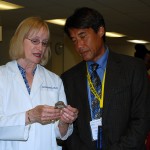
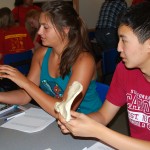
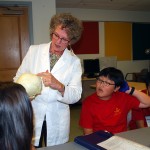
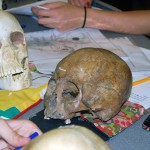
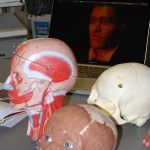

This is my first year assisting in the administrative side of this event, and I can wholeheartedly say that Dr. Lee and his student assistants put an immense amount of work weeks in advance in preparation for this event. I sat in on the fingerprint development and lifting session, and saw how their preparations are essential to their success. These kids have kits, equipment, and everything they need to have a true hands-on experience that they won’t forget any time soon.